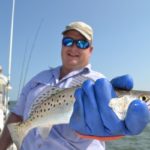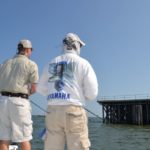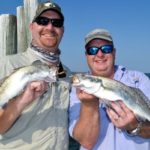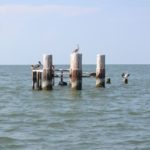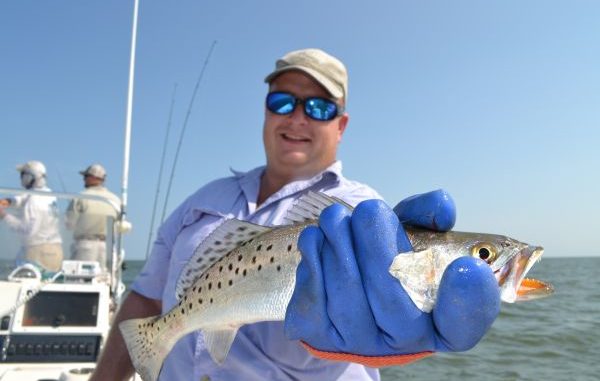
These avid anglers catch plenty of trout out of Dularge this time of year without ever bringing along live bait.
Live bait was designed by Satan himself.
It’s surely not a coincidence, then, that it’s all Louisiana speckled trout will hit in the heart of summer when the air is thick and heavy, and temperatures are hotter than hell.
Consider live bait for a moment. You have basically two options to acquire it. You can either pull a trawl, which means getting up at an hour when most people are going to bed to drag for bait in the pitch dark to make sure you’re on the fishing grounds before the armada of boats arrives from the various marinas, or you can purchase it.
Because of the hassle involved with option No. 1, most people go with option No. 2 — and that’s not a bad one if you’re Warren Buffet’s banker. Depending on where you fish along the coast, those popping shrimp or drumming croakers will set you back 30 to 50 cents apiece. Take along 100 per person, and you’re in the hole upwards of $50 per person before you ever leave the dock.
Then you always have dead loss. Some of the shrimp the marina dropped in your bucket may have been caught the previous night, but others may have been in the tank for a week. Yes, they were alive when you bought them, but the 30-minute boat ride bouncing around in a small bait well was like putting an invalid centenarian on a roller coaster.
By the time you reach your first stop, a not-insignificant percentage of your bait is swimming in baitfish heaven with Neptune.
And sure, maybe your first stop of the day is the trout version of a shopping mall the day after Thanksgiving, and you pull one in on every cast. More than likely, though, the spot has a few trout, but also its share of hardheads, gafftops, Spanish mackerel and ladyfish.
With each trash fish, the cash register rings.
Go tell your bait purveyor after the trip that you want a refund because his shrimp caught more ladyfish than speckled trout, and he’ll likely tell you that you should have your own special on Comedy Central.
Again, live bait was designed by Satan himself.
Capt. Travis Miller agrees. That’s why he hardly ever touches the stuff. This time of year, Miller regularly leaves the dock with a baitwell that’s as dry as a marathoner’s throat.
Is he a purist? Does he own a bait company? Is he content bringing in lighter ice chests than everyone else?
Hardly.
Miller regularly limits this time of year because he fishes one of the last bastions of sanity along the Louisiana coast — Dularge. It’s almost as if the fish there haven’t yet been conditioned that they should only hit live bait in the summer. That’s an absurd proposition, of course, but fish there with plastics in the summer, and you’ll swear it’s true.
Perhaps there’s a reason for it: Live bait is tough to come by in the area. The marinas don’t stock croakers and shrimp, so anglers’ only options are to catch it themselves or pay an arm, leg and first-born child at a local houseboat that stocks it.
Most anglers who fish the area regularly refuse to do either, so they resort to catching fish the same way they do in autumn, winter and spring — with soft-plastics.
“The name of the game for us is double rigs,” Miller said.
Apparently it is. Last June, after four weeks of stiff winds made getting to the nearshore rigs in the area an impossibility on any consistent basis, Miller decided to take advantage of a break in the weather to scout for fish with his good friend, Capt. Marty LaCoste.
It was a Wednesday, and the forecast was for conditions to improve dramatically over the next several days. So Miller, LaCoste and Ray Falgout (a buddy of Miller’s) left Jug’s Marina at 2:30 in the afternoon with the bow pointed toward Enstar, a flat box of pilings and support beams that attracts baitfish and speckled trout. It’s a summer staple for the Dularge fleet.
A 10-mph wind out of the southeast made the ride to Enstar a bit bumpy, but after the conditions of the previous weeks, it felt like slick glass to Miller and LaCoste. They circled the rig looking for bait and to determine the direction of the current before moving within casting distance of a group of pilings that sits just off the rig.
Within minutes, LaCoste got a short strike. He set the hook, and there was nothing there. Mere moments later, Falgout yanked back on his rod, and reeled a keeper into the boat. Then Miller did the same. Then LaCoste caught a double.
The fish were all legal, but they were on the small side, so LaCoste switched over to a swimbait in hopes of drawing strikes from bigger fish.
“I’ll start off with a double rig, but typically, if they’re not hitting a double rig, they’re going to hit a swimbait,” he said. “For some reason, when we get late in June, sometimes they’ll quit hitting those double rigs, and the swimbait must mimic whatever they’re feeding on. It kind of looks like a little croaker.
“A lot of times this time of year, they’ll switch from feeding on shrimp to croakers.”
Although LaCoste works his double rigs fairly vigorously, he doesn’t do the same with the swimbaits.
“No twitching on the swimbait,” he advised. “All I’m doing is reeling it. Right now, I find these fish are on the bottom, so I’m letting it sink and just barely, barely reeling.”
The hits kept coming on both the swimbaits and double rigs, but there wasn’t a noticeable uptick in size, so the anglers decided to leave feeding speckled trout to make the short run to the Pickets.
There, they found healthier fish, particularly Falgout, whose chicken-on-a-chain soft plastics were being crushed with regularity.
After 15 or so were added to the collection, the bite slowed down, and the crew moved to the 26 rig that sits within a stone’s throw of the Pickets.
There, the action was ridiculous. The three anglers worked around the rig, anchoring whenever the bite got heavy and trolling when it slowed.
It was just about the perfect fishing trip: The fish were easy to find, they hit like a bag a bricks was dropped on the end of your line and, best of all, there wasn’t a single breed of live bait anywhere on the boat.
“Typically, nine out of 10 times, we’re fishing with 1/4-ounce jigheads on double rigs,” LaCoste said. “When you get a strong, strong current, then we have to go to 3/8-ounce (jigs) to get the baits down a little farther.”
Top baits for the guides are Matrix Shads and Cocodrie Cocahoes in avocado, LSU and glow/chartreuse.
Annual hotspots in the area, in addition to the Pickets, Enstar and 26, are Raccoon Island, Mardi Gras, 28 and Blue Point, and any of those spots could be hotter than the others at any given moment. That’s why Miller and LaCoste fish them quickly with their trolling motors on weekdays with little competition.
On weekends, they’ll tie off to the rig or anchor to protect access to what they feel will be the day’s hotspot.
“You should not be sitting on a spot for too long,” Miller said. “On the weekend, I’ll stay at my first spot a little longer than I normally would just to try to be a little patient because a lot of times, I get out there right at daybreak; sometimes you need just a little more sun.
“There’s a ton of places to fish, so just keep moving.”
Even though he’s on the water every day this time of year, LaCoste still hunts for the fish on every trip.
“It’s just a matter of pulling up to the rig, putting the trolling motor down and circling the rig until you find them,” he said. “Some days they could be high; some days they’re low, and some days they just want the bait to drift in the current. It’s different every day.
“Typically, you’re going to find them upcurrent, but then there’s a lot of days you find them downcurrent.”
Anglers who don’t want to burn the fuel getting to the big rigs, or who don’t have sufficient crafts to do it safely, can still do well closer in, according to Miller.
“A great spot is Coon Point,” he said. “A lot of that island is starting to dissipate, but you can fish the beach and the rocks.
“There’s a lot of fish still on the coast, so you don’t necessarily have to run out there if you don’t have a big boat. Get your 18-, 20-foot boat right there, and you’ll be fine.”
Fine indeed. The devil can keep his damned live bait.
For more information, call Miller at 985-981-6434 or LaCoste at 985-856-4477.
